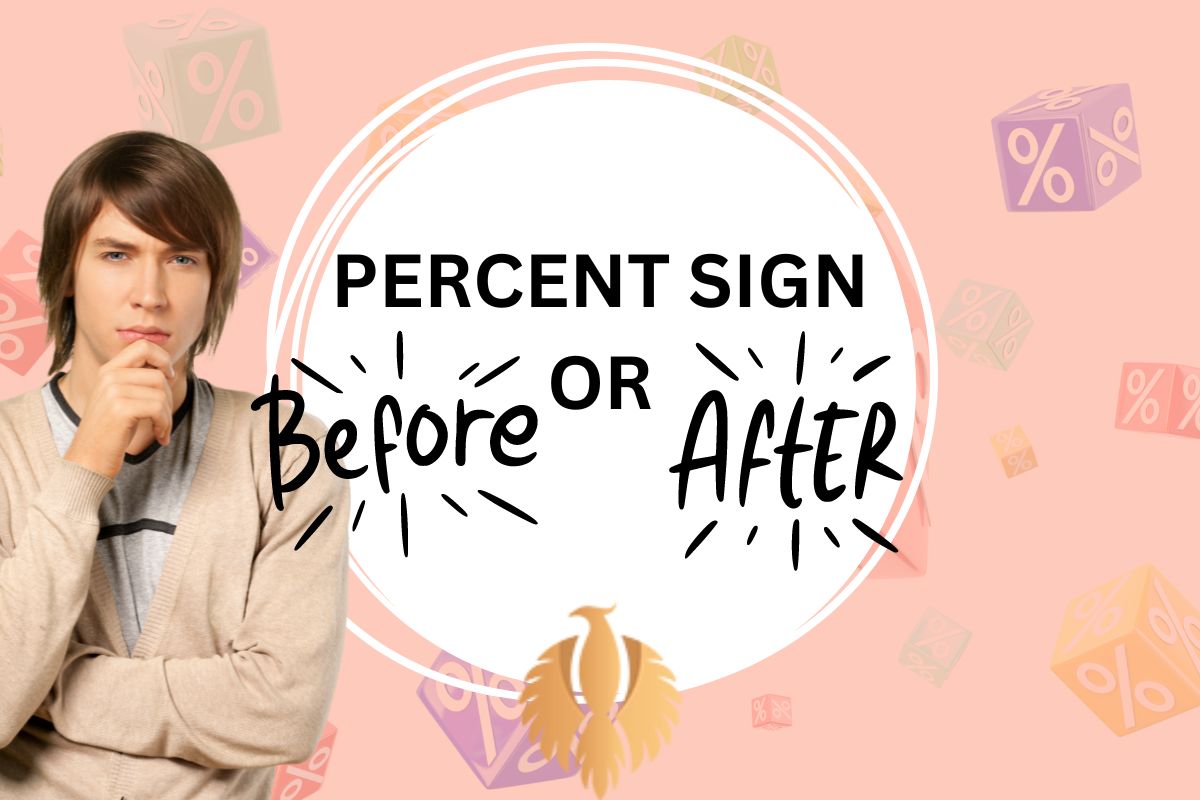The percent sign should be placed after the numerical value it modifies, as in “50%.” This is the standard convention used in English writing, mathematics, and various professional documents.
In the realm of writing, mathematics, and professional documentation, the placement of the percent sign can sometimes lead to confusion and debate among individuals across different disciplines.
In this guide, titled “Percent Sign Before Or After [2025 Guide] Differences + Examples,” we will explore the common usage of the percent sign, which is to position it after the number.
This placement not only aids in clarity but also aligns with conventions used in mathematics and statistics globally.
While the general rule favors placing the percent sign after the number, there are certain contexts and exceptions that can arise based on the field of study, regional preferences, or even specific software requirements.
For instance, in programming languages or specific mathematical equations, you may encounter instances where the percent sign appears in unique contexts that deviate from the standard placement.
Understanding these nuances is critical for effective communication, allowing individuals to convey information accurately and avoid misunderstandings.
This guide will delve into various scenarios where the placement of the percent sign may differ, providing comprehensive examples to illustrate each case.
By examining common mistakes, disciplinary preferences, and contextual exceptions, we aim to be a definitive resource for anyone looking to refine their understanding of this important grammatical element.
As language evolves, new conventions may emerge, influencing how we use symbols like the percent sign in writing and communication.
Therefore, this guide not only addresses the current standards but also reflects on how emerging trends and technological advancements could shape future usage.
By the end of this guide, you will have a solid grasp of when to place the percent sign before or after numbers and a deeper understanding of the principles guiding these grammatical choices.
With clear differences highlighted through examples and contextual applications, you’ll be well-equipped to apply the appropriate conventions in your writing. Let’s delve into the details and clarify any uncertainties you may have regarding the correct usage of the percent sign!
Does the percent sign go before the number or after?
In English, the percent sign typically goes after the number. For example, “25%” represents 25 percent.However, it’s worth noting that conventions can vary in different languages and contexts.
In some languages, like French, the percent sign is placed before the number (e.g., “25 %”). Always adhere to the specific style or guidelines relevant to the language or context you are writing in.
You might also enjoy:Which of the Following: Definition + Complete Usage + Grammar
How do you use the percent sign in a sentence?

The percent sign is used to express a proportion or a percentage of a whole. Here are some examples of how to use the percent sign in a sentence:
| 1. After the number: |
| – “The company achieved a profit margin of 15% last quarter.” |
| – “She scored 90% on her exam.” |
| 2. With words: |
| – “Approximately 20 percent of the population attended the event.” |
| – “They estimated that 75 percent of the project was completed.” |
| 3. In comparisons: |
| – “The price increased by 10% over the past year.” |
| – “His salary was reduced by 5 percent during the economic downturn.” |
It’s common to use the percent sign after the number, but specific style guides or language conventions may vary.
- Standard Placement
The conventional rule in English writing is that the percent sign is placed after the number it quantifies. This placement is universally recognized across publications, educational institutions, and professional settings.
Correct: The growth rate was 50%.
Incorrect: The growth rate was %50.
- Usage in Percentages
Percentages are often used to illustrate changes in statistics, financial reports, or research findings. Following the standard format helps maintain clarity and fosters understanding among readers.
Correct: The company reported a 20% increase in sales, indicating effective marketing strategies.
Incorrect: The company reported a %20 increase in sales, which can confuse readers.
- Statistical Representation
In fields like analytics and research, using correct percent placement is crucial for data presentation. Incorrect usage can lead to misinterpretation of statistical information.
Correct: Only 75% of study participants responded to the survey, highlighting engagement issues.
Incorrect: Only %75 of study participants responded to the survey, which may cause confusion.
- Academic Writing
In academic publications, adherence to proper grammar and formatting enhances the credibility of the work. This includes correct percent sign placement.
Correct: The exam passing rate was 90%, reflecting the effectiveness of the new curriculum.
Incorrect: The exam passing rate was %90, which is not consistent with academic writing standards.
- Financial Reports
Financial documentation often emphasizes numeric accuracy and clarity. Correct placement aids in precise communication of financial data.
Correct: The investment returned 8%, demonstrating significant gains despite market volatility.
Incorrect: The investment returned %8, which could mislead stakeholders.
- Market Research
Percentages are used extensively in marketing analytics to provide insights into consumer behavior. Consistent placement enhances readability.
Correct: 65% of consumers prefer shopping online, indicating a shift in market trends.
Incorrect: %65 of consumers prefer shopping online, which can look unprofessional.
- Visual Data Representation
When interpreting data visually through charts or graphs, the correct representation of percentages is vital for audience understanding.
Correct: The pie chart shows that 40% of respondents prefer coffee to tea, illustrating clear preferences.
Incorrect: The pie chart shows that %40 of respondents prefer coffee to tea, obscuring information accuracy.
- Describing Discounts
Retail and pricing strategies often involve the use of percentages, where incorrect formatting can lead to consumer misunderstanding.
Correct: You can save 25% on your next purchase, encouraging customer engagement.
Incorrect: You can save %25 on your next purchase, which may confuse potential buyers.
- Population Statistics
Demographic studies frequently utilize percentages to communicate findings clearly. Correct usage impacts the interpretation of social data.
Correct: 15% of the population is under 18 years old, shaping policy decisions related to youth services.
Incorrect: %15 of the population is under 18 years old, which can be seen as sloppy.
- Sports Statistics
Sports analytics and reporting rely heavily on percentages to convey performance metrics. Consistent presentation standardizes understanding.
Correct: The team secured a win rate of 70%, which is an impressive statistic.
Incorrect: The team secured a %70 win rate, which looks unusual and less professional.
You Might Also Enjoy:Reinforce Vs Reenforce: 10 Differences + Examples [2025]
- Usage in Recipes
Percentages can help provide precise measurements in culinary contexts. Clarity in writing encourages better cooking outcomes.
Correct: Add 10% more water for better consistency in the dough.
Incorrect: Add %10 more water for better consistency, which might confuse cooks.
- Health Guidelines
Public health recommendations often use percentages to communicate dietary guidelines effectively, affecting population health.
Correct: Doctors recommend that 30% of your diet be fruits and vegetables for optimal health.
Incorrect: Doctors recommend that %30 of your diet be fruits and vegetables, which is ambiguous.
- Sales Promotions
In advertising, the success of campaigns is often measured in percentages, where accurate representation is critical for marketing effectiveness.
Correct: This week, there’s a 50% off sale storewide, enticing shoppers to take action.
Incorrect: This week, there’s a %50 off sale storewide, potentially causing confusion about the sale.
- Job Market Statistics
Employment data frequently employs percentages to reflect rates of joblessness or market health. Proper formatting is essential for clarity.
Correct: The unemployment rate is at 4%, pinpointing economic stability.
Incorrect: The unemployment rate is at %4, which appears incorrect or informal.
- Graduation Rates
Educational institutions use percentages to communicate success metrics effectively. Accurate representation enhances institutional credibility.
Correct: The school had a graduation rate of 92%, which is an impressive achievement.
Incorrect: The school had a graduation rate of %92, which can seem unprofessional.
- Customer Satisfaction
Research on customer satisfaction often uses percentages to quantify feedback. Correct usage is crucial for transparent reporting.
Correct: Surveys indicated an 85% satisfaction rating among users, demonstrating the service’s success.
Incorrect: Surveys indicated a %85 satisfaction rating, which might lead to misinterpretation.
- Interest Rates
Economic reports often feature percentage rates detailing loans or savings, where accurate decimal and percent placement is critical.
Correct: The interest rate is currently at 3%, influencing borrowing decisions.
Incorrect: The interest rate is currently at %3, which can confuse readers interpreting financial data.
- Research Findings
Academic and scientific findings often cite percentages to showcase results. Consistency in format aids in the clarity of communication.
Correct: 78% of respondents favored the new policy, indicating public support.
Incorrect: %78 of respondents favored the new policy, which is unconventional.
- Census Data
Census reports utilize percentages to describe demographic trends, thus ensuring accuracy is vital.
Correct: According to the census, 60% of households own a car, indicating transportation needs.
Incorrect: According to the census, %60 of households own a car, which looks unprofessional.
- Electricity Usage
In sustainability discussions, percentages help quantify energy efficiency improvements. Correct representation fosters clear discussions.
Correct: The average household saves 15% on electricity by using energy-efficient appliances, promoting sustainability.
Incorrect: The average household saves %15 on electricity, which is unconventional.
You might also enjoy:Where Does “How is your Day Going?” Originate From?
- Effectiveness of Programs
Various programs measure their impact in percentage terms, where accurate notation enhances credibility.
Correct: Expect a 10% increase in community engagement following the new initiative.
Incorrect: Expect a %10 increase in community engagement, which can confuse readers.
- Industry Growth Rates
Business reports often highlight growth rates in percentage terms; clarity here enhances the impact of the message.
Correct: The industry experienced a 12% growth over the past year.
Incorrect: The industry experienced a %12 growth over the past year, which is less appropriate.
- Advertising Metrics
Marketing professionals use percentages to gauge campaign effectiveness. Correct formatting conveys professionalism.
Correct: Click-through rates improved by 12% due to the new ad strategy.
Incorrect: Click-through rates improved by %12, appearing less formal.
- Education Metrics
Education settings often rely on percentages to evaluate student performance; thus, clarity and professionalism are critical.
Correct: 40% of students are involved in extracurricular activities, demonstrating engagement.
Incorrect: %40 of students are involved in extracurricular activities, which could lead to confusion.
- Economic Policies
Policymakers often rely on percentages to report the results of initiatives; proper usage bolsters clarity.
Correct: The program aims for a 20% reduction in carbon emissions by 2030.
Incorrect: The program aims for a %20 reduction in carbon emissions, which may confuse stakeholders.
- Inflation Rates
Economic indicators such as inflation are often represented in percentage terms; correct placement is necessary for understanding.
Correct: The inflation rate was reported at 3.5%, affecting consumer prices.
Incorrect: The inflation rate was reported at %3.5, which can confuse readers.
- Safety Metrics
Safety reports often communicate effectiveness in terms of percentages; clarity ensures accurate understanding of risks.
Correct: The factory reported a 25% decrease in workplace accidents.
Incorrect: The factory reported a %25 decrease in workplace accidents, which is less effective.
- Performance Metrics
Companies may report on performance improvements using percentages; accurate placement ensures credibility.
Correct: Employee productivity increased by 18% in the last quarter.
Incorrect: Employee productivity increased by %18 in the last quarter, which may look unprofessional.
- Environmental Impact
Statistics on environmental impact often rely on clear percentage data for comprehension; correctness is essential.
Correct: There has been a 30% reduction in plastic waste due to the initiative.
Incorrect: There has been a %30 reduction in plastic waste, leading to potential confusion.
- Technology Adoption
In tech, adoption rates are frequently conveyed in percentages, where correct usage can influence strategic decisions.
Correct: The tech company saw a 40% increase in user adoption within six months.
Incorrect: The tech company saw a %40 increase in user adoption, which could discount their findings.
- Public Health Initiatives
Efforts in public health often measure success with percentages; clear communication is vital.
Correct: Vaccination rates are up to 85% within the community, illustrating effectiveness.
Incorrect: Vaccination rates are up to %85 within the community, which is less conventional.
- Consumer Trends
Trends in consumer behavior are often measured in percentages; proper usage aids comprehension.
Correct: 60% of consumers are willing to switch brands for sustainability.
Incorrect: %60 of consumers are willing to switch brands for sustainability, which may confuse audiences.
- Web Analytics
Online metrics often utilize percentages to report on user engagement; clarity enhances interpretation.
Correct: The website saw a 50% increase in unique visitors last month.
Incorrect: The website saw a %50 increase in unique visitors, which appears informal.
- Sales Forecasts
In sales reports, projections are often presented as percentages; accurate formatting defines professionalism.
Correct: The company projects a 10% increase in sales for the coming quarter.
Incorrect: The company projects a %10 increase in sales, which shows a lack of attention to detail.
- Housing Market Data
Real estate analyses often involve percentages to show trends; formatting should remain consistent.
Correct: Housing prices surged by 20% according to the latest forecast.
Incorrect: Housing prices surged by %20 according to the latest forecast, which can seem sloppy.
You might also enjoy:Interested In or On: The Differences + Examples [2025]
- Nutritional Guidelines
Nutritionists often utilize percentages to provide dietary recommendations; precision is critical.
Correct: It is suggested that 50% of your food intake come from carbohydrates for a balanced diet.
Incorrect: It is suggested that %50 of your food intake come from carbohydrates, which lacks professionalism.
- Industry Analysis
Analysis in various industries often highlights market trends in percentage terms; clarity is key.
Correct: The technology sector has seen a growth rate of 25% this year.
Incorrect: The technology sector has seen a %25 growth rate this year, which is unconventional.
- Student Assessments
When evaluating academic performance, schools often report results in percentages; correct usage aids in communication.
Correct: 90% of students passed the final exam, showcasing overall success.
Incorrect: %90 of students passed the final exam, which looks unprofessional.
- Project Management
Percentages help communicate project completion statuses clearly; accuracy is crucial in reporting.
Correct: The project is currently 80% complete, ahead of schedule.
Incorrect: The project is currently %80 complete, which is less formal.
- Advertising Success
In advertising metrics, companies often quantify reach and engagement using percentages; correct notation is vital.
Correct: The ad campaign reached an audience of 70%, translating into higher engagement.
Incorrect: The ad campaign reached an audience of %70, which appears unprofessional.
- Feedback Metrics
Collecting customer feedback typically involves percentages to illustrate sentiments; precise formatting encourages understanding.
Correct: 65% of respondents rated their experience as excellent.
Incorrect: %65 of respondents rated their experience as excellent, which seems informal.
- Event Participation
Organizers often report event attendance in percentage terms to assess engagement; accuracy affects the interpretation of success.
Correct: The conference saw participation from 55% of registered attendees.
Incorrect: The conference saw participation from %55 of registered attendees, which lacks clarity.
- Consumer Savings
Promotions highlight consumer benefits in percentages; clarity ensures effective communication of savings.
Correct: Customers can save 30% on select items during the sale.
Incorrect: Customers can save %30 on select items during the sale, which may be confusing.
- Economic Indicators
Understanding economic conditions often requires interpreting percentage data; proper usage supports effective communication.
Correct: Economic growth was reported at 3% last quarter.
Incorrect: Economic growth was reported at %3 last quarter, which could lead to misinterpretation.
- Program Evaluation
Evaluating program outcomes often involves percentages; accuracy is essential for presenting tangible results.
Correct: The initiative resulted in a 15% increase in community engagement.
Incorrect: The initiative resulted in a %15 increase in community engagement, which is unconventional.
You might also enjoy:What Kind of Vs What Kinds of – Differences + Examples [2025]
- Donation Campaigns
Fundraising efforts often emphasize success rates in percentage terms; proper usage enhances credibility.
Correct: The campaign raised 85% of its goal within three weeks.
Incorrect: The campaign raised %85 of its goal within three weeks, which looks unprofessional.
- Technology Adoption Rates
Tracking how quickly technology is adopted by users often requires a clear representation of percentages.
Correct: The new software has been adopted by 40% of departments.
Incorrect: The new software has been adopted by %40 of departments, which appears less formal.
- Satisfaction Surveys
Feedback from customers on services is often quantified in percentages; accuracy is key to interpreting data correctly.
Correct: 90% of customers expressed satisfaction with our service.
Incorrect: %90 of customers expressed satisfaction with our service, which looks unprofessional.
- Health Survey Results
Health organizations frequently report survey results using percentages; correct formatting fosters clear communication.
Correct: According to the survey, 70% of people are aware of the health guidelines.
Incorrect: According to the survey, %70 of people are aware of the health guidelines, leading to confusion.
- Influencer Marketing Data
In marketing, influencer effectiveness is often quantified with percentages; clarity in representation encourages strategic decision-making.
Correct: The influencer campaign achieved a 60% engagement rate across all platforms.
Incorrect: The influencer campaign achieved a %60 engagement rate across all platforms, which looks unprofessional.
Do you put a space before percent sign?

The use of a space before the percent sign depends on the style guide or conventions of the language you are writing in.
In many English-speaking contexts, including American English, it’s common to not use a space before the percent sign, like “25%.”
However, in some languages and regions, a space might be used before the percent sign, as in “25 %”.
It’s essential to be consistent with the conventions of the specific style guide you are following or the requirements of the context in which you are writing.
You might also enjoy:Too Cute Meaning Vs To Cute (To Vs Too) + Examples
What is the correct way to use the percentage symbol (%) or the word percent?
The usage of the percentage symbol (%) or the word “percent” depends on the context and the style guide you are following. Here are the common conventions:
- Symbol (%):
– Use the percentage symbol (%) after the number, without a space. Example: “25%.”
- Word “percent”:
– Use the word “percent” when writing formal documents or expressing percentages in words. Example: “Twenty-five percent.”
When to use one over the other often depends on the formality of the writing. In more formal or academic contexts, you might prefer using the word “percent.” In everyday writing or informal contexts, the percentage symbol is commonly used for brevity.
Always check the specific style guide or guidelines of the publication you’re writing for to ensure consistency and accuracy.
What is the percent rule in AP style?

The AP Stylebook recommends using the percentage symbol (%) with numerals and to avoid using the word “percent” except in casual references or when it starts a sentence.
The AP Style suggests using numerals with the % symbol and no space. Here’s an example: “The price increased by 10%.”
Keep in mind that style guides may receive updates, so it’s advisable to check the most recent edition of the AP Stylebook or any specific updates beyond my last knowledge update in 2022 for the latest guidelines on this matter.
Why is there a space in percent?
The use of a space in or around “percent” is a matter of language conventions and style guides. Different languages and style guides have varying rules regarding spacing with the word “percent” or the percent symbol (%).
In English, particularly in American English, it is common to not use a space before the percent symbol. For example, “25%.” However, in some languages and regions, a space might be used before the percent symbol, like “25 %.”
The inclusion or omission of a space is a stylistic choice guided by language conventions and the rules of the specific style guide or publication you are following. Consistency within a document or context is crucial for clarity and readability.
You might also enjoy:How Are You Fairing or Faring? Differences + Examples
How the percentage sign is used in a document?
The percentage sign (%) is used in a document to represent proportions or ratios as a fraction of 100. Here are some common ways to use the percentage sign in a document:
- After Numerals:
– Use the percentage sign directly after a numeral to indicate a percentage. For example: “25% of the population.”
- In Tables and Charts:
– Percentages are often used in tables and charts to represent proportions or distribution. Ensure clarity by using the percentage sign consistently.
- With Numerals or Words:
– You can use either numerals or words to express percentages. For example: “15% or fifteen percent.”
- In Text:
– Use the percentage sign in sentences to convey proportions or comparisons. For example: “The company achieved a growth of 10%.”
- No Space:
– In many English contexts, including American English, it’s common to use the percentage sign without a space, like “30%.”
Remember to follow the specific style guide or document conventions you are working with to ensure consistency and accuracy in the usage of the percentage sign throughout your document.
Do you write out percent?

Whether to write out “percent” or use the percent symbol (%) depends on the style guide or specific guidelines you are following. In many cases, especially in more formal writing and publications, using the percent symbol is preferred for clarity and brevity.
For example, “25%” is a common way to express a percentage in numerical form.
However, some style guides, or when writing in a more narrative or casual style, might recommend writing out the word “percent.” For example, “twenty-five percent” is the written-out form.
Always check the specific requirements or style guide of the publication you are writing for to ensure consistency with their guidelines.
What are three ways to write a percent?
There are various ways to write a percent, but three common ways include:
- Using the Percent Symbol:
– Write the numerical value followed by the percent symbol (%), like “25%.”
- Writing Out the Word “Percent”:
– Express the percentage using words, such as “twenty-five percent.”
- Combination of Numerals and Words:
– Use a combination of numerals and words, for example, “15 percent” or “5%.”
The choice often depends on the style guide or specific guidelines you are following, as well as the formality of the document or context. Always ensure consistency in your chosen method throughout your writing.
You Might Also Enjoy: Top 60 Most Common Simple Sentences In English
Does the percent sign go before the number or after?
In English, we usually place the percent sign (%) after the number. For instance, “25%” indicates 25 percent.
This practice is commonly accepted across various fields, such as academic writing, business documents, and daily conversations.
Positioning the percent sign after the number, clearly shows that the figure represents a percentage, making it straightforward to read and comprehend.
That said, it’s important to recognize that different languages and contexts may have their conventions.
For example, in French, the percent sign appears before the number (e.g., “25 %”). This variation in placement is simply a typographical choice and does not alter the meaning of the percentage.
Being mindful of these differences is crucial, especially when addressing an international audience or working in a multilingual setting.
English Usage
In English, the standard practice is to place the percent sign immediately after the number without any space. Here are some examples:
• Example 1: The company’s profits increased by 10% this year.
• Example 2: Only 5% of the participants completed the survey.
• Example 3: The discount on the product is 20%.
In these examples, the percent sign follows the number directly, which is the correct format in English.
Variations in Other Languages
As mentioned earlier, the placement of the percent sign can vary in other languages. In French, for instance, the percent sign is placed after the number but with a space in between. Here are a few examples:
• Example 1: Les bénéfices de l’entreprise ont augmenté de 10 % cette année.
• Example 2: Seulement 5 % des participants ont complété le sondage.
• Example 3: La réduction sur le produit est de 20 %.
In these examples, the space between the number and the percent sign is a typographical convention in French.
Contextual Considerations
When writing, it’s crucial to adhere to the specific style or guidelines relevant to the language or context you are writing.
For instance, academic and professional writing often follows specific style guides such as the APA, MLA, or Chicago Manual of Style, which provide detailed rules on the use of percentages and other numerical data. Here are a few tips:
1. Consistency: Always be consistent in your use of the percent sign within a document. If you start with placing the percent sign after the number, continue to do so throughout the document.
2. Style Guides: Refer to the relevant style guide for your writing context. Different fields and publications may have specific preferences for the use of percentages.
3. International Audience: If you are writing for an international audience, consider the conventions of the primary language of your audience. This can help in making your writing more accessible and understandable.
You might also enjoy:Emersion Vs Immersion: Meaning, Differences, and Examples
Practical Examples
To further illustrate the correct usage of the percent sign in different contexts, here are some practical examples:
• Business Report: The market share of the company increased by 15% over the last quarter.
• Academic Paper: Approximately 30% of the respondents agreed with the statement.
• Everyday Communication: I got a 90% on my math test!
In each of these examples, the percent sign is placed after the number, following the standard English convention.
In summary, the percent sign typically goes after the number in English, such as in “25%.” However, conventions can vary in different languages and contexts.
For example, in French, the percent sign is placed after the number with a space in between (e.g., “25 %”). Always adhere to the specific style or guidelines relevant to the language or context you are writing in to ensure clear and effective communication.
By understanding these conventions, you can use percentages correctly and confidently in your writing.
How do you write 100 percent?

“100 percent” is written out as words, representing the full or complete amount. It is commonly used to indicate full completion or total agreement. If you prefer to use numerals and the percent symbol, you would write it as “100%.”
Do I use a or an before 100%?
The choice between “a” and “an” depends on the pronunciation of the following word.
– If the following word begins with a vowel sound, use “an.” For example, “an 100% accurate result.”
– If the following word begins with a consonant sound, use “a.” For example, “a 100% success rate.”
In this case, since “100%” is pronounced “one hundred percent,” and “one” begins with a vowel sound, you would use “an.” For example, “an 100% accurate measurement.”
How to do percentages for beginners?
To calculate a percentage, multiply the given number by the percentage as a decimal. For example, to find 20% of 50, multiply 50 by 0.20. If you want to increase a number by a percentage, add that percentage of the original number to it. For a decrease, subtract the percentage.
How do I figure out the percentage of a number?
To find the percentage of a number, multiply the number by the percentage expressed as a decimal. For example, to find 15% of 80, you would multiply 80 by 0.15 (15% as a decimal), resulting in 12. So, 15% of 80 is 12.
You might also enjoy:Looking Forward To Seeing You: Grammar + Examples[2025]
How do you solve a percentage problem?
To solve a percentage problem, follow these steps:
- Identify the known values:
– The original value (e.g., the total amount).
– The percentage you’re working with.
– If you’re finding a part of the whole or an increase/decrease.
- Convert the percentage to a decimal:
– Divide the percentage by 100.
- Use the appropriate formula:
– For finding a percentage of a number: Multiply the original value by the decimal equivalent of the percentage.
– For finding the original value, if you know the part and the percentage: Divide the part by the decimal equivalent of the percentage.
- Simplify and solve:
– Calculate the result, making sure to simplify if necessary.
Remember, practice helps reinforce these steps!
What is the percent equation example?

The percent equation is expressed as:
\[ \text{Part} = \left(\frac{\text{Percentage}}{100}\right) \times \text{Whole} \]
For example, if you want to find 25% of 80:
\[ \text{Part} = \left(\frac{25}{100}\right) \times 80 = 0.25 \times 80 = 20 \]
So, 25% of 80 is 20.
What is the basic percent equation?
The basic percent equation is:
\[ \text{Part} = \left(\frac{\text{Percentage}}{100}\right) \times \text{Whole} \]
This formula is used to find a part (the unknown value) when you know the percentage and the whole. Alternatively, you can rearrange the formula to find the whole or the percentage, depending on the information you have.
What is the formula for percent proportion?
The percent proportion formula is:
\[ \frac{\text{Part}}{\text{Whole}} = \frac{\text{Percentage}}{100} \]
This formula is useful when you know two values among the part, whole, and percentage, and you want to find the third. It’s a way to express the relationship between a part and a whole when dealing with percentages.
What is percent solution and examples?
A percent solution typically refers to a solution where the solute (substance being dissolved) is expressed as a percentage of the total solution. The formula for percent concentration (% mass/volume or % m/v) is:
\[ \text{Percent Concentration} = \left(\frac{\text{Mass of Solute}}{\text{Volume of Solution}}\right) \times 100 \]
For example, if you have 50 grams of sugar dissolved in 500 milliliters of water, the percent concentration would be:
\[ \text{Percent Concentration} = \left(\frac{50 \, \text{g}}{500 \, \text{mL}}\right) \times 100 = 10\% \]
So, the sugar solution is a 10% solution.
You might also enjoy: Top 100 Commonly Used Verbs That Start With D [2024]
What is the meaning of percentage in math?
In mathematics, a percentage is a way to express a fraction or a ratio as a portion of 100. The term “percent” is derived from the Latin phrase “per centum,” meaning “per hundred.” It is represented by the symbol “%”.
The percentage is often used to describe proportions, comparisons, or ratios. For example, if you say you scored 80% on a test, it means you got 80 correct answers out of 100 questions. The percentage is a convenient way to represent fractions and proportions in a standardized form, making it easier to compare different quantities.
How do you write 90% as a fraction?
To write 90% as a fraction, you can express it as \(\frac{90}{100}\). To simplify this fraction, you can divide both the numerator and denominator by their greatest common factor, which is 10.
\[ \frac{90}{100} = \frac{90 \div 10}{100 \div 10} = \frac{9}{10} \]
So, 90% is equivalent to \(\frac{9}{10}\) as a fraction.
How do you write 0.9 as a percentage?
To write 0.9 as a percentage, you multiply the decimal by 100 and add the percentage symbol.
\[ 0.9 \times 100 = 90\% \]
So, 0.9 written as a percentage is \(90\%\).
You might also enjoy: GNG Meaning In Text and TikTok [My 2024 Update]
Why do we use percentage?
Percentages are used for several reasons in various contexts:
- Comparison and Standardization: Percentages provide a standardized way to compare different quantities, making it easier to assess relative sizes or changes.
- Expressing Proportions:Percentages represent proportions out of 100, making it simple to communicate parts of a whole in a standardized form.
- Financial Calculations:Percentages are widely used in finance for interest rates, discounts, and other calculations related to money.
- Grading and Assessment: In education, percentages are commonly used to represent scores and grades, offering a clear measure of performance.
- Data Representation:Percentages are often used to represent statistical data, such as the percentage of a population with a certain characteristic.
- Convenience and Communication: Percentages provide a convenient way to express fractions and ratios in a standardized and easily understandable manner.
In essence, percentages simplify communication and analysis, allowing for a more straightforward understanding of proportions and comparisons in various fields.
Conclusion
In conclusion, the placement of the percent sign, whether it comes before or after the number, is a matter of style and convention.
In the English language, the most common practice is to place the percent sign after the number, like “25%.” This convention is widely accepted and helps ensure clarity and consistency in written communication.
However, it’s important to recognize that conventions can vary in different languages and contexts.
For instance, in French, the percent sign typically comes before the number, as in “25 %.” These variations are influenced by regional or institutional guidelines and typographical norms.
Understanding these differences is crucial, especially when writing for an international audience or in a multilingual context.
In mathematical expressions or technical contexts, adherence to specific style guides is essential.
Style guides such as the APA, MLA, or Chicago Manual of Style provide detailed rules on the use of percentages and other numerical data.
Consistency in the usage of percent signs ensures clarity and understanding in written communication, preventing confusion and misinterpretation.
Ultimately, while the position of the percent sign may vary, it is essential to maintain consistency within a given context or document.
This consistency helps avoid confusion and ensures that the intended meaning is conveyed accurately.
The choice of placement is more a matter of convention than a strict grammatical rule, but adhering to the relevant guidelines is crucial for effective communication.
In summary, the percent sign typically goes after the number in English, such as in “25%.” However, conventions can vary in different languages and contexts.
For example, in French, the percent sign is placed before the number with a space in between (e.g., “25 %”). Always adhere to the specific style or guidelines relevant to the language or context you are writing in to ensure clear and effective communication.
By understanding these conventions, you can use percentages correctly and confidently in your writing.
Whether you are writing a business report, an academic paper, or everyday communication, using the correct placement of the percent sign is essential for clarity and professionalism.
Remember to check the specific style guide or guidelines of the publication you are writing to ensure consistency and accuracy.
In essence, the placement of the percent sign is a small but significant detail in writing.
Paying attention to such details can greatly enhance the readability and professionalism of your work.
So, next time you use a percentage in your writing, remember these guidelines and ensure that your usage aligns with the conventions of your language and context.
This attention to detail will help you communicate more effectively and professionally, whether you are writing for a local or international audience.

Hi, welcome to my blog! My name is Omid and I am thrilled to have you here! I am an English language teacher with 12 years of experience and hold multiple international certifications (TESOL, IELTS, TOEFL, PTE, CELTA). Additionally, I hold a PhD in Applied Linguistics with a specialization in Teaching English as a Second Language (TESL), which fuels my passion for teaching English and assisting others in mastering the language. To me, nothing is more rewarding than helping individuals enhance their English language abilities through various methods. So, let’s embark on this journey of learning English together.




